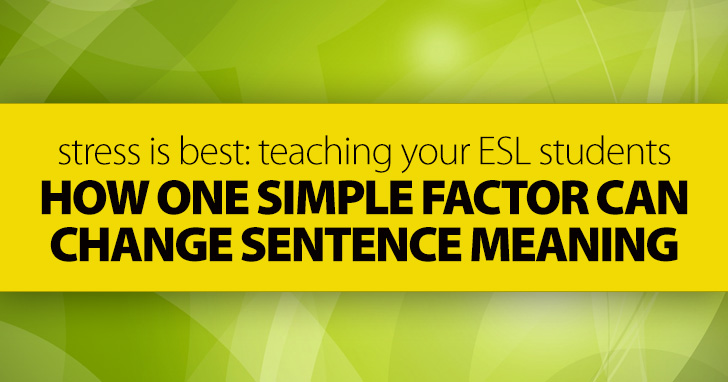Stress About It: 7 Tips for Teaching English Intonation


You and your ESL students are probably familiar with the stresses of life on the English language learning roller coaster. And while that kind of stress can change how you understand what other people say, it is the emphasis on particular words as they are spoken, sentence stress, that really makes a difference in what you mean by what you are saying. ESL students need to understand and practice stressing different words in a sentence and how that affects the meaning of a sentence. Here’s a breakdown of what sentence stress means and how to practice it with your ESL class.

We see two basic sentence intonation patterns in English. In the first pattern, the tone of voice falls at the end of a sentence. We see this primarily in statements, but we also see it in information questions (those that start with who, what, where, when, why, and how). The second common intonation pattern in English is a rise at the end of the sentence. We use this pattern when asking yes/no questions.
When we talk about sentence stress, however, we are talking about stressing one word in a given sentence. Generally, when we stress a word, we imply that specific item might be untrue, in other words, we bring it into question. When we stress one word, we put emphasis and question on that specific word. We can stress any word in a sentence to cast doubt on that particular item. Look at the following sentences. In each a different word is stressed, and the way each sentence is stressed implies a different meaning
| I did not say you broke my green pencil. | Implies that I did not say it, but someone else did. |
| I did not say you broke my green pencil. | Implies that I did not say it though I may have communicated my feelings in another manner such as implying or showing. |
| I did not say you broke my green pencil. | Implies that it was someone else who broke it. |
| I did not say you broke my green pencil. | Implies that you did something else to it other than breaking it. |
| I did not say you broke my green pencil. | Implies that you broke another person’s green pencil. |
| I did not say you broke my green pencil. | Implies that you broke another pencil but not the green one. |
| I did not say you broke my green pencil. | Implies that you broke some other green item but not the pencil. |
In each of these examples, we question one fact in the sentence. We imply that particular item is not true while the rest of the sentence still is.
Practice: You can practice listening for sentence stress with this activity. On a table at the front of the room, put a green pencil, another pencil that is not green, another item that is green that isn’t a pencil, and any fourth item. Have one person leave the room, and have someone else in the class move one or more items on the table. Then have the first person come back into the room and accuse one or more students in the class of moving the green pencil. That person should deny the accusation. Then have the first person say, “I didn’t say you moved my green pencil.” They should stress one word in the sentence, implying additional meaning to what they are saying. The second student then responds, “But you think I…” and finishes the sentence with something that shows they understood the sentence stress. For example, an interaction might go like this.
Play until all students have a chance to leave the room and then accuse their classmates.

We can also stress the helping verb in a sentence. This conveys a slightly different meaning than stressing the other words in the sentence. Take the following examples.
By stressing any of these words, the speaker emphasizes what is true. They are disagreeing with what someone else has said and stressing that what they are saying is true. In other words, the speaker wants his listener to know that he did not say anything even though the listener may think that he did.
Practice: You can do an activity to practice this kind of sentence stress with the same setup as the previous exercise. This time, when a student comes in after something on the table has been changed, he or she points at one student (student B) and then whispers something in another student’s ear (student C). Student B then accuses student A of saying something, and both student A and student C take turns denying that student A said it. For example, a conversation might look like this.
Continue the exercise until every student has the chance to leave the room.
Stress can be stressful, but if you take the time to point out to your students what it means, they won’t have to stress out about it.